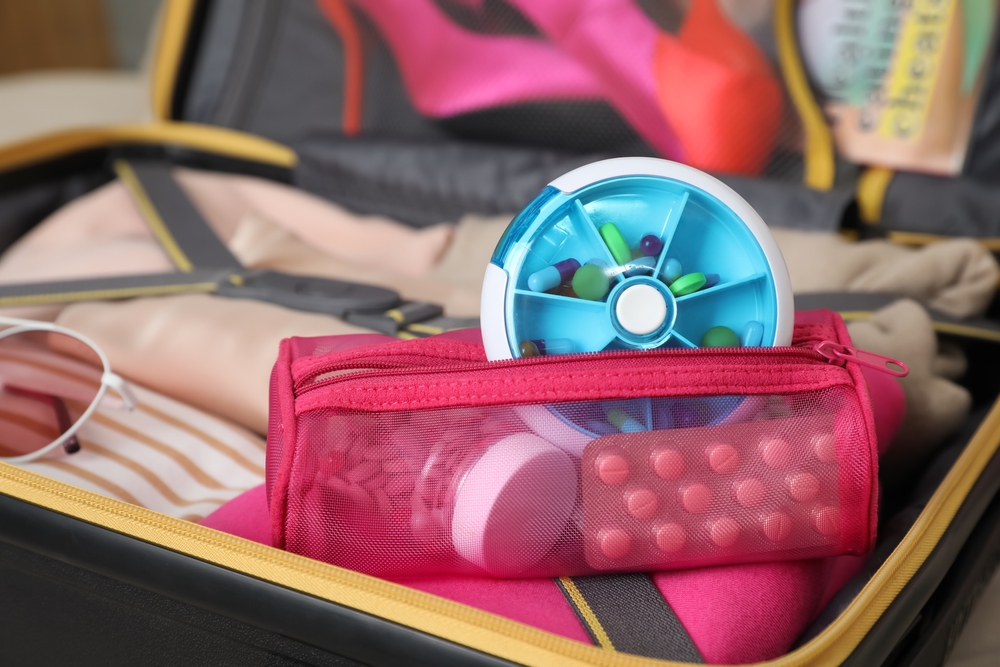Borders are continually opening up and most countries around the world are inviting tourists to visit. What handy medicines should you pack for your upcoming holiday? We got some tips for you! Read on to learn the art of packing pre-emptive medications into your carry-on when you are going overseas.
Traveller’s Diarrhoea
Food poisoning is the most common issue that travellers might potentially encounter. A simple recommendation to reduce the risk of getting food poisoning is to “boil it, cook it, peel it, or forget it”. Despite taking these necessary precautions, some factors such as restaurant hygiene are beyond your control. If you are down with traveller’s diarrhoea, you would usually experience watery diarrhoea, stomach cramps and abdominal discomfort. In more severe cases, you might have vomiting and fever.
Over-the-counter medications which may be useful for managing symptoms include:
- Paracetamol for the fever and pain
- Antidiarrhoeals like
- Charcoal pills to aid in adsorption and expulsion of ingested toxins
- Loperamide to reduce gastric motility and thus the frequency of visits to the toilet
- Hyoscine Butylbromide (Buscopan) for stomach cramps
- Oral Rehydration Salt Solutions (ORS) to replace fluids and electrolytes lost from vomiting or diarrhoea
Fortunately, symptoms of most travellers’ diarrhoea usually resolve after 2-3 days. Should the symptoms persist or worsen, however, it is advisable to consult a doctor.
Motion Sickness
If you are an adventurous traveller who loves going on bumpy safari car rides, boat trips or scuba diving, motion sickness pills are a must prepare. You may consider medications like cinnarizine or dimenhydrinate (Novomin). Remember to pop the pill about 30 minutes to 1 hour before the journey for best efficacy. Do note that motion sickness pills usually cause drowsiness. If you feel sleepy, avoid activities that require concentration like driving. For non-drowsy alternatives, there are products on the market such as tablets that contain Zingiber officinale (ginger) root powder or homoeopathic medications. Interestingly, there are even reusable nausea relief wristbands with a button that is placed face-down over the Nei-Kuan point, which claims to provide a drug-free solution for motion sickness. The effectiveness of these alternatives varies between individuals.
Cough, Cold, Flu
It is common to catch the flu bug when travelling in a new environment. So it is important to pack small quantities of everything that would make you feel better and more comfortable if you are down with a common cold. Below are possible symptoms and the recommended medications to relieve each symptom:
- Sore throat – Lozenges, gargles, throat sprays that contain antiseptic (like povidone-iodine, chlorhexidine, Cetylpyridinium) and anaesthetic (like lignocaine, benzocaine) are great to relieve throat pain. Some products even have anti-inflammatory components (like benzydamine hydrochloride) to reduce the swelling in the throat and for fast pain relief.
- Cough – Cough syrups that contain dextromethorphan or pholcodine help to suppress the cough. If it is too troublesome to bring liquid, some tablets or lozenges contain the same active ingredients to stop the cough.
- Phlegm – Effervescent tablets or oral tablets that contain bromhexine or acetylcysteine can thin and loosen the phlegm (mucus in your airways), helping you to cough out the phlegm more easily to clear the chest congestion.
- Blocked Nose and Runny Nose – There is a myriad of medications that can help with runny and blocked nose. For convenience, you can opt for combination tablets that contain both antihistamine (for the runny nose) and decongestant (for the blocked nose). You can choose non-drowsy medications to take during the daytime or drowsy ones to take at night if you are unable to fall asleep due to a blocked or runny nose. Drowsy medications e.g. containing Chlorpheniramine, and Triprolidine have to be bought from a pharmacist while non-drowsy ones e.g. containing fexofenadine, cetirizine, loratadine can be bought off the shelves.
Most importantly, while having fun and exploring the world, remember to have sufficient rest, stay hydrated and observe good hand hygiene (wash your hands often with soap and water or an alcohol-based hand sanitiser containing more than 60% alcohol) to prevent catching the virus from infected people or surfaces. Hand sanitisers and wet wipes are a must-pack and lifesavers for both children and adults when you need to clean up.
First Aid
A small, well-stocked first aid kit with topical antiseptic cream (to kill bacteria and virus), mild steroid cream (for allergic reactions or insect bites) and simple dressing materials for cuts and scrapes, would also come in handy. This is especially if you are travelling with young kids, who are prone to get accidental abrasions, or if you are going for outdoor activities like hiking or water sports.
Conclusion
It is impractical and impossible to be packing medications for any and every eventuality. So it is important to identify the common issues that might happen on a trip and be prepared for them. A final piece of advice would be to remember to protect your medications from extreme hot or cold temperatures, as these can affect the efficacy of the medications. If you are taking an aeroplane, keep the medications in your carry-on baggage. If you are travelling by car, never leave your medications in the trunk or the car when the engine is switched off. Passport? Check. Itinerary? Check. Medications? Check.













